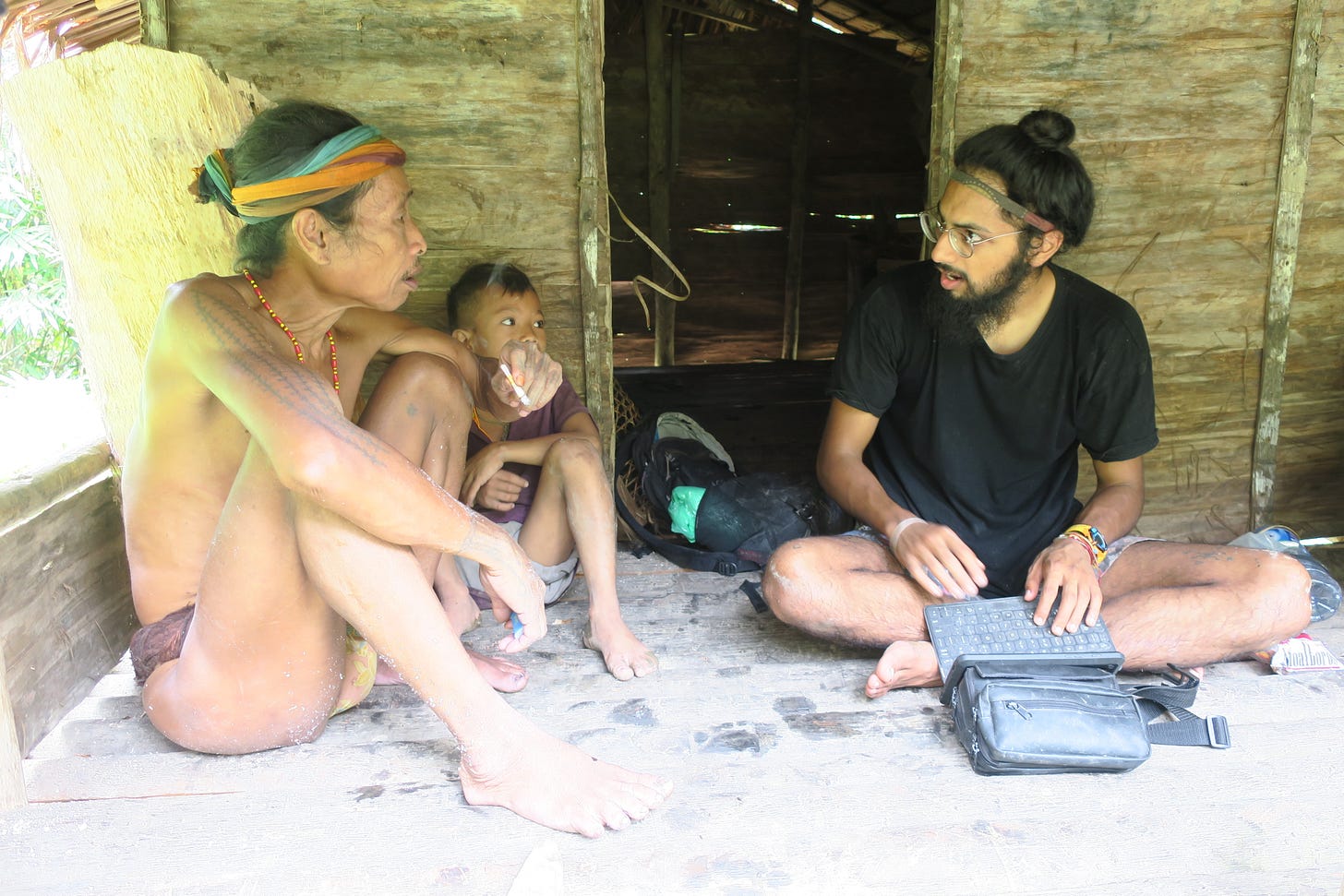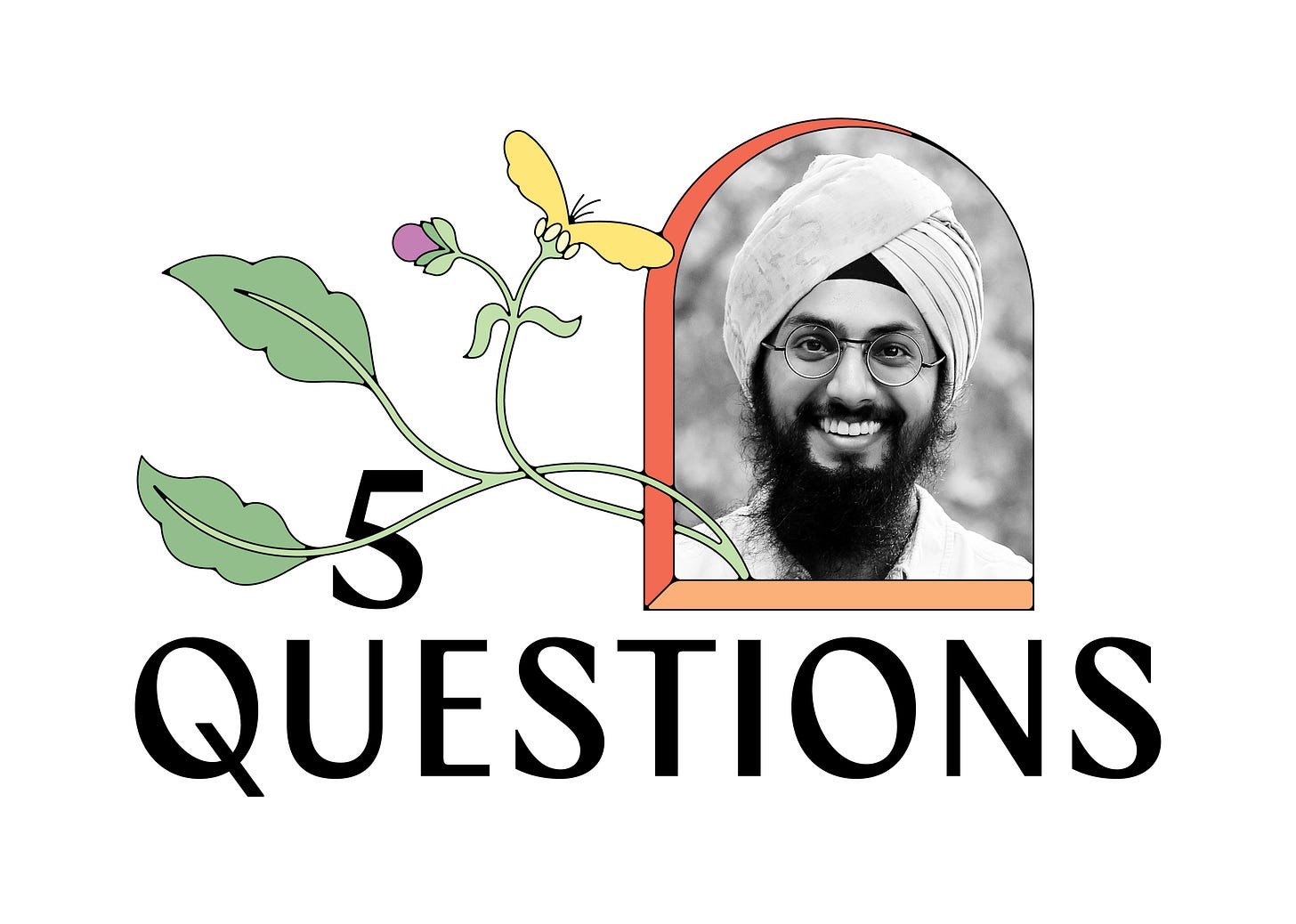Shamanism and psychedelics: 5 Questions for Manvir Singh
Singh discusses convergences between shamanism and psychedelics, and their role in modern spirituality.
In the summer of 2014, after his first year in a Harvard anthropology PhD program, Manvir Singh flew to Siberut, an island off the coast of Indonesia, to live with the Mentawai people. He was primarily interested in Indigenous religion and how the community managed conflict, but as soon as he arrived, he was “dazzled by shamanism.” Shamans in the community immediately stood out: tattoos adorned their skin, and though most others in the community had adopted modern clothes, shamans still wore loincloths. During ceremonies, they painted their bodies in turmeric; they wore beaded necklaces and headbands. After that summer, Singh read more about shamanism across the world — and kept returning to the Mentawai, learning the language and even eventually building a small house in the village.
Singh, now an assistant professor of anthropology at University of California at Davis, recently published Shamanism: The Timeless Religion. The Microdose spoke with him about convergences between shamanism and psychedelics, and their role in modern spirituality.
What is shamanism, and what do you think mainstream depictions of shamanism get wrong?
The definition I prefer includes three features. One: the practice of entering altered states of consciousness. Two: while in those states, engaging with unseen agents, gods, ghosts, witches, ancestors. And three: using that engagement to provide services like healing or divination, or even weather control.
Throughout the 20th century there’s been a debate over how to define shamanism, but also a recognition that there are interesting resonances and parallels across very diverse contexts. You have practitioners providing services and entering non-ordinary states, but how do we draw lines around what counts? Shamanism is so entangled with the primitive and the exotic and the orient — many people would be comfortable using the term shaman for people in Siberia, Korea, or the Amazon, but my definition would include practices from Pentecostal pastors, Hebrew prophets, or even trance mediums. I don’t think you can justifiably draw lines around the exotic while excluding manifestations of the same tendency in Western societies.

People often want to know whether psychedelics can heal people, and what role expectations or set and setting have in doing that. In the book, you discuss some similar ideas in your research on shamanism: you mention the role of theatrics and performance in shamanism. You write that people often ask you whether you think shamanism is “real.” What do you tell people who ask you that, and what parallels do you see between psychedelic-assisted therapy and shamanism?
In the book, I get into why I don’t think the evidence is there that shamans are engaging with unseen agents, but there’s still good reason to believe that what they provide is therapeutic.
This “real vs. not real” distinction is less salient for practitioners or the people they work with than those who come from a Western intellectual tradition. That’s a tradition heavily influenced by Christianity, where faith and reality and belief are heavily prioritized. Something I’ve come to appreciate in my own experiences in these contexts is that whether things are real or not real seems tangential to whether I’m responding to it, or whether people around me seem to be responding to it.
I often want to argue that shamanism and psychedelic-assisted psychotherapy share less than people sometimes like to think. On the one hand, people will say things like, “psychedelic psychotherapy is recreating or drawing upon something that has been present in shamanic practices for a long time.” I think that’s inaccurate or misleading because overwhelmingly in those contexts, it’s the specialist, the shaman, who’s taking the psychedelic, not the client. And it’s not being done to change thought patterns — the way it’s understood in a psychiatric model — but rather as a means of achieving special powers and engaging with special beings. Additionally, there can sometimes be a whitewashing of the use of psychoactive substances, including psychedelics, which downplays the ways in which they are also entangled with aggression, witchcraft, and sorcery. But on the other hand, I do think that shamanic healing and psychedelic assisted psychotherapy both can create really powerful experiences that allow patients to change their stories about themselves.
Subscribe for more interviews and our weekly news roundup. (P.S. It’s free!)
You also write that shamanism is a “mind technology: a moving performance that assures people a practitioner can perform the extraordinary,” one that can have positive effects, including allowing people to rewrite those stories about themselves. What else about shamanism creates such a powerful experience for people?
I think of shamanism as a package of practices and associated beliefs that function to create a compelling experience, where a specialist is engaging with beings and forces thought to oversee the uncontrollable, unpredictable and uncertain events in life, especially illness. The foremost way it does that is through creating a mindscape where, again, expectation and belief are less important than we might think. Rather, other things might be more important, like the degree to which a person feels empathy from the practitioner, or how immersive an experience is. And shamanism is very well designed to do both of those things — it’s sound, touch, performance, music, sometimes psychoactive drug use, fire, night, and the shaman is understood to be deeply empathetic, since they are engaging with beings thought to be dangerous on behalf of someone else, which can be seen as an expression of love or commitment for that person.
Anthropologist Polly Wiessner describes being healed as an affirmation of love, also because it’s often a collaboratively created experience where many people in a community are collaborating to allow the shaman to do their work, so you are essentially being healed by the work of many.
There is a resurgence of interest in not only psychedelics, but also shamanism. You argue that shamanism has always existed, and will always exist in some form. Why are we seeing this rising interest in shamanic practices?
There are a few factors at play that I think are currently contributing to this turn towards not only shamanism, but other things like astrology, tarot, and neopaganism. The first is that in times of general uncertainty, people turn to magical or religious practices. A shaman is a hyper compelling means of dealing with uncertainty.
Another factor is the decline of affiliation with institutionalized religion; fewer people identify as spiritual or religious, and many people who identify as spiritual say they are not religious — and look for other kinds of spiritual outlets.
Also, there is declining trust in institutionalized knowledge and expertise. This is why you have people who are conspiracy theories also turning to spiritual traditions; when you no longer have trust in science or universities and the like, you turn back to more intuitive ways of knowing.
And a final thing is the rise of ecstatic religion in the face of falling centralized authority. Historically, when you have declining power with one, you have a rise in the other. Many religions have started out super ecstatic and shamanistic, but as they become institutionalized and centralized, they become more hierarchical and there is an attempt from more centralized power structures to quash those more ecstatic manifestations. They want to have more jurisdiction over people’s relationship with the supernatural, rather than allowing people to claim they have a direct relationship with the divine. You see this in many sects of Christianity, like Quakers — they literally quaked — and in Mormonism.

An excerpt of your book was recently published in The Guardian, where you argue that despite modern narratives of psychedelics as widely used around the world for millennia, reliable evidence of classic psychedelics is mostly limited to the Americas, and often postcolonial. What has the reception to that piece been like? And why do you think that there seems to be an attachment to this idea of psychedelic traditions being thousands of years old?
Overwhelmingly, the response to my piece has been positive; many have said that we should responsibly ground our claims in what the evidence shows. But others have said that if we’re making this argument on the basis of anthropologists, missionaries, and explorers, couldn’t it be the case that those people missed the use of these substances, or that it was intentionally hidden? For sure, definitely — I think that’s plausible. And there are outstanding mysteries, like what soma is, or reports of “mushroom madness” in New Guinea, and how mushrooms grow in South Africa and Lesotho. Credibility of the evidence for each of those varies, and there should be more investigation. But absence of evidence is not an invitation to make up evidence.
We’re in a moment where many people are eager about broader societal acceptance of psychedelics, and many are confronting a knee-jerk resistance to them, so saying these are not a newfangled drug but an element of deep and widespread spiritual tradition gives them a softer edge. It also frames them as a lost Indigenous wisdom, which is often the type of wisdom people hunger for when they're dissatisfied with modern society. In many ways, the stories we tell about spiritual tradition are tools for critiquing or celebrating our own traditions.
This interview has been edited and condensed for clarity and length.







